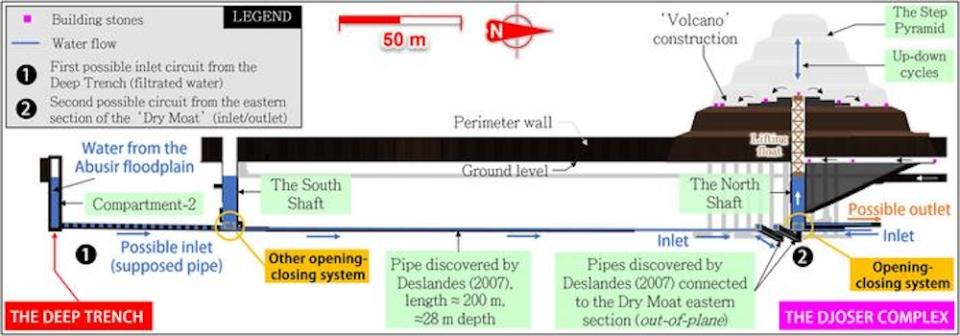The honor of Egypt’s oldest necropolis belongs to Pharaoh Djoser, a ruler who ushered in the Old Kingdom’s Third Dynasty during the 27th century BCE. Constructed around 2,680 BCE in Saqqara, northwest of the ruins of Memphis, the six-tier, four-sided Step Pyramid of Djoser stood amid a large courtyard filled with decorative ceremonial structures. And while ancient Egyptians relied on a number of tools to help build the roughly 205-foot-tall structure, a new study indicates at least one previously unknown aid—a hydraulic lift system utilizing a nearby, longgone lake.
The evidence was made available on August 5 by an interdisciplinary team at France’s CEA Paleotechnic Institute writing in the journal PLOS One. After combining satellite imagery, geospatial data analysis, watershed information, and other techniques, the researchers hypothesize a previously unexplained structure near the Step Pyramid likely functioned as a “check dam” for capturing water and sediment. An ancient engineering structure dating back millennia, check dams are comparatively simple designs used to interrupt and slow water flows.




In the Pyramid of Djoser’s case, a water source appears to have channeled through multiple compartments, allowing the sediment to settle while passing through each successive chamber. After traveling through the compartments, some of the water then likely flowed into pyramid shafts built to help builders raise massive building stones to their desired positions. What is particularly interesting is that, although many societies didn’t use check dams for filtration, it appears the pyramid’s may have also served as an water treatment facility. Additionally, the Pyramid of Djoser’s dam predates some of the earliest known examples by hundreds, if not thousands, of years.
To illustrate the concept, researchers described a simple example of how ancient Egyptians may have operated such a hydraulic-check dam system. Based on their analysis, the team believes the lift’s floating platform rose to a maximum height of around 55 feet, but potentially employed modifications to ascend even higher using collapsible extension structures. After reaching the top of the pyramid, the lift platform may have also functioned as a counterweight through the use of pulley-and-rope systems. Combined with additional construction methods like ramps and levee systems, the hydraulic lift may have only been used intermittently when enough water was available. Even so, researchers stressed the lift’s potential existence fundamentally alters what experts believe ancient Egyptians were capable of creating.
[Related: ‘Screaming woman’ may solve a 3,500-year-old mummy mystery.]
“The hydraulic lift mechanism seems to be revolutionary for building stone structures and finds no parallel in our civilization,” they write in their paper, adding that its utility “is so significant that it seems beyond just building the Step Pyramid.” Combined with its water treatment capabilities, the architects’ planning would also “reflect their foresight in meeting various civil needs,” such as making the Saqqara region hospitable for permanent settlement, including agriculture, water access, and long term shelter.
The team argue their findings also raise the possibility that ancient Egyptians utilized similar systems in other Old Kingdom pyramids, and perhaps even earlier. The only way to know for sure, however, is to continue exploring and analyzing these ruins.







